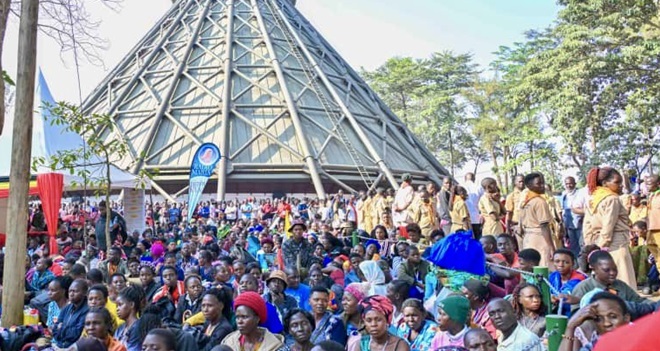
Namugongo, Uganda | THE INDEPENDENT | This year’s Martyr’s day celebration has had a special pomp with exceedingly more people from all walks of life flocking the Catholic shrines.
By 6:00 a.m, all spaces inside the shrines were full, yet more pilgrims continued to arrive, forming long queues at every entrance point.
“This might be the largest crowd to ever attend this event. Indeed, each year, this place attracts more people, except during the COVID-19 lull,” one of the organizers noted.
Before the event, the shrines had been expanded with more spaces created in the wooded areas behind the central pavilion. However, every available space, whether green or concrete, was already occupied by morning.
Despite having special clearance to bypass the queues, our reporter took an hour to access the entrance and other 30 minutes to pass into the crowd to access the pavilion.
The Namugongo event is reputed to be the largest one-day gathering in Uganda, with organizers claiming attendance figures of up to 4 million people in recent years. While it is undeniable that the event attracts massive crowds, several experts have disputed these figures.
President Museveni to address the congregation at the 60-year anniversary celebration of the canonization of the Uganda Martyrs at Namugongo Catholic Shrine. #ChimpReportsNews #MartyrsDay @KagutaMuseveni pic.twitter.com/hvjl258ZOT
— Nyamate (@JBNyamate) June 3, 2024
Meanwhile, although many were pushing to enter, several were equally trying to leave. One of those exiting was Alex Musaazi, a pilgrim from Lukaya. Musaazi noted that he had spent the night at the shrine, completed his prayers, and was now heading home.
“The internet is off. We cannot broadcast,” was the desperate cry from several media teams as they scrambled to find solutions. Some thought interchanging internet provider might save the day, but all efforts were in vain.
“We should send someone to buy a UTL line; it might be on,” suggested a journalist from the Holy Cross Catholic team. However, a neighbor from Radio Maria informed her that he was using UTL, and it was also down. Some media outlets, like NTV, had to leave their established stations to find areas where they could conduct live broadcasts using mobile units.
“It has been hard for us to broadcast today. Since morning, the network has been jammed, and we seem to have come to participate like other pilgrims,” noted Solomon Kaweesa, a journalist at NTV. The situation was so dire that even phone calls could not be made.

Later, it was discovered that the network had been jammed by the presidential security team on the ground. Media groups pleaded with the central organizing committee to request that the Special Forces Command (SFC) team allow them to work.
At this moment, officers from the presidential press unit moved towards the press area to assess how the media had been affected. Alex Atuhairwe, a member of the organizing committee coordinating the press, later informed the media that they had spoken to the president’s security team to have the jammers turned off so the media could broadcast.
“We have engaged them, and they are handling it,” Atuhairwe told the journalists, who were feeling increasingly frustrated by the situation.
The President’s security team often jams networks as a security measure, especially in areas where high-profile officials, including the president, are in attendance.
Information from Britannica shows that in military activities, jamming is frequently employed to confuse enemy radar or communications.
The techniques of jamming are numerous and varied, but most involve broadcasting a powerful radio signal, modulated with noise, on the precise frequency of the signal being jammed. This disrupts the targeted communication by overwhelming it with interference, rendering it ineffective.
After engaging the security team, the network was restored. However, when President Yoweri Kaguta Museveni and First Lady Janet Museveni arrived at the event, the network was disrupted again, affecting the event managers who relied on wireless equipment for sound.
“The microphones can’t work. The jammer is on. We’ve been jammed. There’s nothing we can do,” noted the technician in the sound box as Charles Odongotho, the Master of ceremonies, came to inquire why he couldn’t use the microphone.
Shortly after the president’s arrival, the mass began. This was a few minutes before 10:00 a.m. However, the sound quality was not as clear as it had been earlier. Later network was resorted again.
Every year, Christians in Uganda and beyond flock to Namugongo to pay homage to 45 young converts who were killed between 1885 and 1887 on the orders of Kabaka Mwanga. Of these, 22 were Catholic converts and were canonized as saints. The 22 martyrs became the first saints from sub-Saharan Africa.
This year marks the 60th anniversary of their canonization, a memorable event that took place in the Vatican, Rome. the celebrations are led by Nebbi Diocese under the theme; As for Me and My Household We Shall Serve the Lord.
****
URN
 The Independent Uganda: You get the Truth we Pay the Price
The Independent Uganda: You get the Truth we Pay the Price





